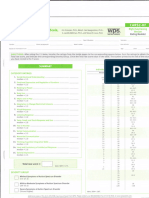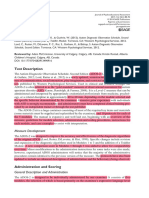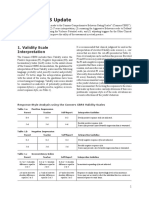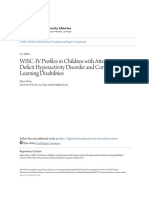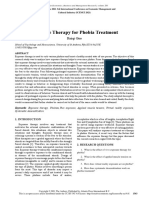0%(1)0% found this document useful (1 vote)
266 viewsWebsite BRIEF A
Website BRIEF A
Uploaded by
loki1138The BRIEF-A is a standardized self-report and informant-report measure that assesses executive functions in adults ages 18-90. It contains 75 items within 9 clinical scales that evaluate behaviors like inhibition, emotional control, and working memory. Scales are grouped into broader Behavioral Regulation and Metacognition indexes and an overall Global Executive Composite score. The BRIEF-A demonstrates good psychometric properties including reliability and validity when compared to other executive function measures. It takes 10-15 minutes to complete and provides T-scores to interpret executive functioning.
Copyright:
© All Rights Reserved
Available Formats
Download as PDF, TXT or read online from Scribd
Website BRIEF A
Website BRIEF A
Uploaded by
loki11380%(1)0% found this document useful (1 vote)
266 views3 pagesThe BRIEF-A is a standardized self-report and informant-report measure that assesses executive functions in adults ages 18-90. It contains 75 items within 9 clinical scales that evaluate behaviors like inhibition, emotional control, and working memory. Scales are grouped into broader Behavioral Regulation and Metacognition indexes and an overall Global Executive Composite score. The BRIEF-A demonstrates good psychometric properties including reliability and validity when compared to other executive function measures. It takes 10-15 minutes to complete and provides T-scores to interpret executive functioning.
Copyright
© © All Rights Reserved
Available Formats
PDF, TXT or read online from Scribd
Share this document
Did you find this document useful?
Is this content inappropriate?
The BRIEF-A is a standardized self-report and informant-report measure that assesses executive functions in adults ages 18-90. It contains 75 items within 9 clinical scales that evaluate behaviors like inhibition, emotional control, and working memory. Scales are grouped into broader Behavioral Regulation and Metacognition indexes and an overall Global Executive Composite score. The BRIEF-A demonstrates good psychometric properties including reliability and validity when compared to other executive function measures. It takes 10-15 minutes to complete and provides T-scores to interpret executive functioning.
Copyright:
© All Rights Reserved
Available Formats
Download as PDF, TXT or read online from Scribd
Download as pdf or txt
0%(1)0% found this document useful (1 vote)
266 views3 pagesWebsite BRIEF A
Website BRIEF A
Uploaded by
loki1138The BRIEF-A is a standardized self-report and informant-report measure that assesses executive functions in adults ages 18-90. It contains 75 items within 9 clinical scales that evaluate behaviors like inhibition, emotional control, and working memory. Scales are grouped into broader Behavioral Regulation and Metacognition indexes and an overall Global Executive Composite score. The BRIEF-A demonstrates good psychometric properties including reliability and validity when compared to other executive function measures. It takes 10-15 minutes to complete and provides T-scores to interpret executive functioning.
Copyright:
© All Rights Reserved
Available Formats
Download as PDF, TXT or read online from Scribd
Download as pdf or txt
You are on page 1of 3
Outcome Measure Behavior Rating Inventory of Executive Function ‐
Adult Version (BRIEF‐A)
Sensitivity to Yes
change
Population Adult
Domain Neuropsychological Impairment
Type of Measure Informant and/or Self‐ratings
ICF‐Code/s B1
Description The BRIEF‐A is a standardised measure that captures views of an adult's
executive functions or self‐regulation in his or her everyday environment.
Two formats are used: a Self‐report and an Informant report.
The Self‐report Form is completed by adults 18‐90 years of age, including
adults with a wide variety of developmental, systemic, neurological, and
psychiatric disorders such as attention disorders, learning disabilities,
autism spectrum disorders, traumatic brain injury, multiple sclerosis,
depression, mild cognitive impairment, dementias, and schizophrenia.
The BRIEF‐A can be completed by an informant who has good knowledge
of the person or as a self‐rating.
The BRIEF‐A is composed of 75 items within nine theoretically and
empirically derived clinical scales that measure various aspects of
executive functioning; Inhibit, Self‐Monitor, Plan/Organise, Shift, Initiate,,
Task Monitor, Emotional Control, Working Memory, Organisation of
Materials. The clinical scales form two broader indexes: Behavioral
Regulation (BRI) and Metacognition (MI), and these indexes form the
overall summary score, the Global Executive Composite (GEC). The BRIEF‐
A also includes three validity scales (Negativity, Inconsistency, and
Infrequency).
The BRIEF‐A takes approximately 10‐15 minutes to administer.
All 75 items are rated in terms of frequency on a 3‐point scale: 0 (never), 1
(sometimes), 2 (often). Raw scores for each scale are summed and T
scores (M = 50, SD = 10) are used to interpret the individual’s level of
executive functioning.
Properties The following information is reported in the manual:
Inter‐rater reliability: The correlation between Self‐Report and Informant
Report forms were moderate (.44‐.68). Approximately 50‐70% of
individuals and their informants reported t‐scores within one standard
deviation of each other. A number of individuals rated themselves as
having more difficulties than their informant (22.2% were between 1‐2 SD
higher, 6.7% were >2 SD higher), whereas only approximately 7% of
individuals reported lower T‐scores on the overall scale than their
informants.
Internal consistency: Cronbach’s alpha for the self‐report form was
moderate to high for the clinical scales (.73‐.90) and high for the indexes
and overall score (.93‐.96). For the Informant Report, internal consistency
was high, ranging from .80‐.98 for the clinical scales, indexes and overall
score.
Test‐retest reliability: Test re‐test correlations for the Self‐Report form
ranged from .82‐.94 for the clinical scales, indexes and overall score, with
an average interval of 4.22 weeks. For the Informant Report, correlations
ranged from .91‐.94 for the clinical scales and correlations for the indexes
and overall score were .96.
Construct validity: Adults with clinical diagnoses (n=18) and a subset of
informants (n=9) completed the BRIEF‐A and the FrSBe. Moderate to
strong correlations were obtained for the majority of scales and indexes.
Importantly, the BRIEF‐A indexes correlated significantly with the
executive dysfunction scale of the FrSBe for both the self‐report form (.63‐
.67) and informant‐report form (.68‐.74). 40 adults from a mixed
healthy/clinical population completed the BRIEF‐A and the DEX. Total
score on the DEX correlated significantly with BRI (.84), MI (.73) and GEC
(.84).
Factor analysis of Self‐Report Form data yielded a 2‐factor solution (i.e.,
Behavioral Regulation, Metacognition) for normative and mixed
clinical/healthy adult samples, accounting for 73% and 76% of the
variance, respectively. Factor analysis of Informant Report Form data also
yielded a similar 2‐factor solution for the normative and mixed
clinical/healthy adult samples, accounting for 81% and 78% of the
variance, respectively.
Concurrent validity: BRIEF‐A Self‐Report forms for 23 patients with TBI
(60% mild, 10% moderate, 30% severe) were compared to 23 healthy
individuals. Significant group differences were found for the GEC (η2 =
.19), BRI (η2 =.23) and MI (η2 = .08), as well as the individual scales Shift
(η2 =
.14), Initiate (η2 = .17), Working Memory (η2 = .26), Plan/Organise (η2
=.22), and Task Monitor (η2 = .22).
Advantages • Is a reasonably brief measure of self‐reported and informant‐
reported EF difficulties.
• Covers various aspects of EF and provides T scores for each scale.
• Strong psychometric properties for each scale, as well as indexes
and GEC.
• Reasonably well priced.
• Can be administered and scored by individuals who do not have
formal training.
Disadvantages • Must score by hand unless purchase computer scoring program.
• Validated in U.S. normative sample.
Additional
Information
Reviewers Skye McDonald
References
Roth, R. M., Isquith, P. K., & Gioia, G. A. (2005). BRIEF‐A: Behavior Rating Inventory of
Executive Function‐‐adult Version: Professional Manual: Psychological Assessment
Resources
You might also like
- Cars2 HFDocument10 pagesCars2 HFCristina TapiaNo ratings yet
- CAARS Observer EnglishDocument2 pagesCAARS Observer Englishramav99759100% (1)
- Michael B First Et Al - SCID 5-RV Structured Clinical Interview For DSM 5 Diagnoses Research Version - Libgen - LiDocument223 pagesMichael B First Et Al - SCID 5-RV Structured Clinical Interview For DSM 5 Diagnoses Research Version - Libgen - Liosiixy100% (1)
- Conners4 Parent Full V4Document5 pagesConners4 Parent Full V4foramNo ratings yet
- CAARS Patient EnglishDocument2 pagesCAARS Patient Englishramav99759100% (1)
- Metacognition Questionnaire 30 MCQ 30Document3 pagesMetacognition Questionnaire 30 MCQ 30Roberto Szenczuk100% (1)
- CIDI Based Bipolar ScreeningDocument1 pageCIDI Based Bipolar Screeninghulmcounsellor03No ratings yet
- Vinelands Report TemplateDocument3 pagesVinelands Report TemplatetebogomohlapamasweNo ratings yet
- B-BAARS English PDFDocument10 pagesB-BAARS English PDFAi SanNo ratings yet
- Abas 3 TemplateDocument2 pagesAbas 3 Templatenathalie.gardnerNo ratings yet
- Autism Diagnostic Observation Schedule - Second Edition (ADOS-2)Document5 pagesAutism Diagnostic Observation Schedule - Second Edition (ADOS-2)shizuka samaNo ratings yet
- Bipolar II Depression Questionnaire-8 Item (BPIIDQ-8) : S2 TableDocument2 pagesBipolar II Depression Questionnaire-8 Item (BPIIDQ-8) : S2 TableLuís Gustavo Ribeiro100% (3)
- Basc 3 Rating Scales SampleDocument28 pagesBasc 3 Rating Scales SampleNoor Farima Urf Saliha100% (1)
- Diagnostic Case Study #1Document6 pagesDiagnostic Case Study #1Fred BaltierraNo ratings yet
- Adhd PMTDocument16 pagesAdhd PMTBhanu Dahiya100% (1)
- TMT ChildrenDocument7 pagesTMT ChildrenJulianaTeixeiraNo ratings yet
- Wraml2 Screen ReportDocument7 pagesWraml2 Screen ReportJulianaTeixeira100% (1)
- Nepsy II Suggested Administration Order PDFDocument5 pagesNepsy II Suggested Administration Order PDFPsy Ramadan El HaweyNo ratings yet
- Schoolagecbcl PDFDocument4 pagesSchoolagecbcl PDFHeni puspitasariNo ratings yet
- Brief 2Document1 pageBrief 2hamzabtoush02No ratings yet
- Brief 2Document3 pagesBrief 2ScribdTranslationsNo ratings yet
- ASD Interview GuideDocument17 pagesASD Interview GuideTereo100% (1)
- PECS Example ADHD Report - 1 - M 16857773Document17 pagesPECS Example ADHD Report - 1 - M 16857773peachypeachyNo ratings yet
- Eyberg Child Behavior Inventory (ECBI) : 36-Item Parent Report of 2-16-Year-OldsDocument8 pagesEyberg Child Behavior Inventory (ECBI) : 36-Item Parent Report of 2-16-Year-OldsGiiszs AlvarezNo ratings yet
- Ados-2 2014Document5 pagesAdos-2 2014Mariana Pestana0% (1)
- Frontal Systems Behavioral Scale (FRSBE)Document4 pagesFrontal Systems Behavioral Scale (FRSBE)ScribdTranslations100% (1)
- Cars 2Document18 pagesCars 2Rijaa MirzaNo ratings yet
- Basc-3 Psimas 2hr Masp 2015Document20 pagesBasc-3 Psimas 2hr Masp 2015Jean Yi CheongNo ratings yet
- Executive Functioning and Intervention PresentationDocument73 pagesExecutive Functioning and Intervention PresentationDrNihilismNo ratings yet
- Conners Rating Scale For Parents Revised L ExampleDocument3 pagesConners Rating Scale For Parents Revised L Examplesirinyamd50% (2)
- The Child Bipolar Questionnaire (CBQ) A Screening Instrument For Juvenile-Onset Bipolar DisorderDocument8 pagesThe Child Bipolar Questionnaire (CBQ) A Screening Instrument For Juvenile-Onset Bipolar DisorderSana KhanNo ratings yet
- Quesioner ABCDocument2 pagesQuesioner ABCJaya AriaNo ratings yet
- Perceive, Recall, Plan, Perform (PRPP) System of Task Analysis: AssessmentDocument35 pagesPerceive, Recall, Plan, Perform (PRPP) System of Task Analysis: AssessmentJacintha Goh0% (1)
- Behavior Rating Inventory of Executive Function BRDocument11 pagesBehavior Rating Inventory of Executive Function BRPatti Stroud GermanNo ratings yet
- Cabi EnglishDocument3 pagesCabi EnglishCarlo CianchettiNo ratings yet
- Autism Spectrum Disorder Checklist: CriterionDocument1 pageAutism Spectrum Disorder Checklist: CriterionArchana SharmaNo ratings yet
- Conners 3 Parent Assessment ReportDocument19 pagesConners 3 Parent Assessment ReportSamridhi VermaNo ratings yet
- Parent-Child Interaction TherapyDocument6 pagesParent-Child Interaction TherapyScribdTranslationsNo ratings yet
- 2019 - Conners 3 ADHD SymptomsDocument18 pages2019 - Conners 3 ADHD Symptomsblanca_dhNo ratings yet
- Vineland 3 Comprehensive Interview Form Sample Rep - 240321 - 221402Document16 pagesVineland 3 Comprehensive Interview Form Sample Rep - 240321 - 221402Buro GroupNo ratings yet
- CBRS-Self-Report Assessment ReportDocument24 pagesCBRS-Self-Report Assessment ReportRafael Sanchez0% (3)
- The Big Five Personality Test (BFPT)Document6 pagesThe Big Five Personality Test (BFPT)Bagas IndiantoNo ratings yet
- Is It ADHD or TraumaDocument5 pagesIs It ADHD or TraumaBojana RSNo ratings yet
- Evaluation Report Example Document 9.2018Document11 pagesEvaluation Report Example Document 9.2018maria reyesNo ratings yet
- Executive Function and Emotion Regulation - Strategy Use in AdolescentesDocument7 pagesExecutive Function and Emotion Regulation - Strategy Use in AdolescentesMiguel Ángel DominguezNo ratings yet
- Conners 4 Table TemplateDocument1 pageConners 4 Table Templatenathalie.gardnerNo ratings yet
- Brief Test ReviewDocument8 pagesBrief Test Reviewapi-2903850200% (1)
- S3 CARS 2 SampleWriteUp 1Document1 pageS3 CARS 2 SampleWriteUp 1Janet FernandezNo ratings yet
- BRIEF2 Protocol Summary Report SampleDocument7 pagesBRIEF2 Protocol Summary Report SampleMageeNo ratings yet
- Assessment of Attention in PreschoolersDocument23 pagesAssessment of Attention in PreschoolersMarilda Ghellere100% (1)
- CBRS SupplementDocument8 pagesCBRS SupplementPragya BajpaiNo ratings yet
- Functional Behaviour Assessment FbaDocument3 pagesFunctional Behaviour Assessment Fbaapi-645048703No ratings yet
- Pep RDocument12 pagesPep Rnays meetNo ratings yet
- The Autism-Spectrum Quotient (AQ) : Evidence From Asperger Syndrome/High-Functioning Autism, Males and Females, Scientists and MathematiciansDocument13 pagesThe Autism-Spectrum Quotient (AQ) : Evidence From Asperger Syndrome/High-Functioning Autism, Males and Females, Scientists and MathematiciansDamian Maya0% (1)
- Piers-Harris Children's Self-Concept Scale, Second Edition: TH THDocument5 pagesPiers-Harris Children's Self-Concept Scale, Second Edition: TH THMJSDelaVegaNo ratings yet
- Cognitive Behavioral Treatment For Depressed AdolescentsDocument17 pagesCognitive Behavioral Treatment For Depressed Adolescentscharoline gracetiani nataliaNo ratings yet
- Becks Anxiety InventoryDocument3 pagesBecks Anxiety Inventorytibahealth99No ratings yet
- Rcads: Nhs Id: Child/ Young Person's NAMEDocument2 pagesRcads: Nhs Id: Child/ Young Person's NAMEgopi krishna ranjanNo ratings yet
- Profile ADHDDocument39 pagesProfile ADHDΚων/να ΠαπNo ratings yet
- Cognitive Model of Postnatal DepressionDocument1 pageCognitive Model of Postnatal Depressionchrispalmer21No ratings yet
- Arabic Version of Child Behavior Checklist (CBCL) For Ages 6-11Document7 pagesArabic Version of Child Behavior Checklist (CBCL) For Ages 6-11MouhChNo ratings yet
- (Psychiatry-Theory, Applications and Treatments) Katlein França, Mohammad Jafferany - Trichotillomania (Hair Pulling Disorder)_ Clinical Characteristics, Psychological Interventions and Emotional EffeDocument126 pages(Psychiatry-Theory, Applications and Treatments) Katlein França, Mohammad Jafferany - Trichotillomania (Hair Pulling Disorder)_ Clinical Characteristics, Psychological Interventions and Emotional EffePaco La MadridNo ratings yet
- CBT Competences - Map Sept 2015Document1 pageCBT Competences - Map Sept 2015Roxana BlejeruNo ratings yet
- Ansari Mahajabeen Abdul ZabbarDocument1 pageAnsari Mahajabeen Abdul Zabbarmahendrajadhav007mumbaiNo ratings yet
- Abdul Basit CASE FULLDocument11 pagesAbdul Basit CASE FULLSyed ShahidNo ratings yet
- Millon Clinical Multiaxial Inventory InfoDocument6 pagesMillon Clinical Multiaxial Inventory InfoZainab HamdaniNo ratings yet
- Understanding The Suicidal MindDocument246 pagesUnderstanding The Suicidal MindLaura AndreiNo ratings yet
- Internal Family Systems NotesDocument3 pagesInternal Family Systems Notesmaddychan2023No ratings yet
- Psych EEDocument6 pagesPsych EESindhuja RamanNo ratings yet
- Assessing Patient Suitability For ShortDocument16 pagesAssessing Patient Suitability For ShortoflynnjenniferNo ratings yet
- 301 Notes For Unit-4 - 2Document13 pages301 Notes For Unit-4 - 2kulkarni.himani19940809No ratings yet
- Q1 - Modules 7 and 8 Coping Mechanism in Middle and Late Adolescence StudentsDocument24 pagesQ1 - Modules 7 and 8 Coping Mechanism in Middle and Late Adolescence StudentskeziahNo ratings yet
- Drug StudyDocument1 pageDrug StudyZia CaldozaNo ratings yet
- Hayashi 2004Document3 pagesHayashi 2004Ribhav GuptaNo ratings yet
- First-Year College Students' Homesickness and Separation Anxiety: Implications For Orientation, Retention, and Social IntegrationDocument11 pagesFirst-Year College Students' Homesickness and Separation Anxiety: Implications For Orientation, Retention, and Social IntegrationANA-MARIA SĂLĂVĂSTRUNo ratings yet
- Personality Development by Enhancing Mental HealthDocument32 pagesPersonality Development by Enhancing Mental Healthjoy cristalNo ratings yet
- ! Aggarwal2013 Cultural Psychiatry, Medical Anthropology and DSM 5 Field TrialsDocument7 pages! Aggarwal2013 Cultural Psychiatry, Medical Anthropology and DSM 5 Field TrialsNina KulenovicNo ratings yet
- Eating DisordersDocument13 pagesEating DisordersRaya LoziNo ratings yet
- Dementia Assignment 2022 Podcast Script FinalDocument4 pagesDementia Assignment 2022 Podcast Script Finalindraneel570No ratings yet
- Autism Spectrum Screening QuestionnaireDocument2 pagesAutism Spectrum Screening QuestionnaireHelen ChengNo ratings yet
- X FragileDocument2 pagesX FragiletzitziricaNo ratings yet
- XLL Practice SampleDocument4 pagesXLL Practice SampleAkshita BatraNo ratings yet
- 216 FullDocument5 pages216 Fullalinaisabelaanghel5306No ratings yet
- Exposure Therapy For Phobia TreatmentDocument4 pagesExposure Therapy For Phobia TreatmentLIZ KHAREEN GIMENEZNo ratings yet
- Cognitive TherapyDocument7 pagesCognitive TherapyMavi YalongNo ratings yet
- Substance-Related and Addictive Disorders (Presentation)Document219 pagesSubstance-Related and Addictive Disorders (Presentation)Ryan Wong [Aizen]No ratings yet
- Adler 2006Document5 pagesAdler 2006ajtorres0000001No ratings yet
- Maintaining Factors of Anorexia Nervosa Addressed From A Psychotherapeutic Group For Parents: Supplementary Report of A Patient's Therapeutic SuccessDocument14 pagesMaintaining Factors of Anorexia Nervosa Addressed From A Psychotherapeutic Group For Parents: Supplementary Report of A Patient's Therapeutic SuccessmargaranaNo ratings yet
- Table-254Document1 pageTable-254Dragutin PetrićNo ratings yet
